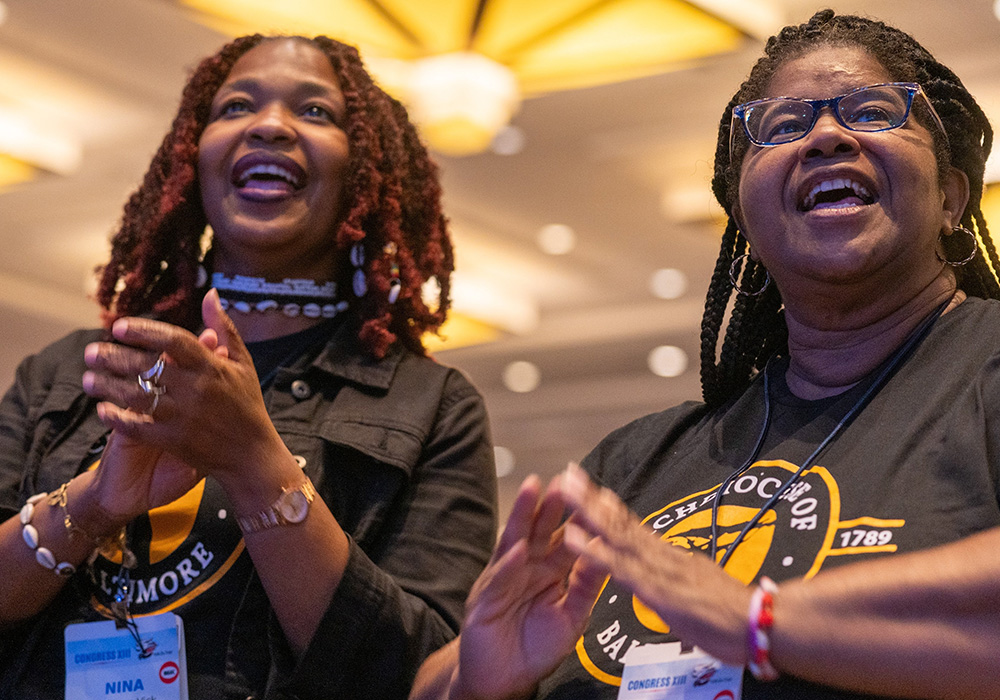
Nina Shipman-Vick and Valerie Grays from the Archdiocese of Baltimore participate in the opening plenary session of the 13th National Black Catholic Congress July 21 at the Gaylord National Resort & Convention Center in National Harbor, Maryland. (OSV News/Catholic Standard/Mihoko Owada)
I had the privilege of attending the National Black Catholic Congress at National Harbor outside Washington, D.C., this July. To say it was a life highlight and the best event I ever attended may be an understatement. About 3,000 Black Catholics gathered with various bishops, priests, religious and white Catholic allies in a weekend of inspiration, fellowship, prayer, song, word and service.
What was most striking to me about the Congress was the energy, talent, spirit and collective solidarity of those in attendance. From standing in the registration line, sitting on the bus, and attending workshops, to eating meals, sitting in Mass, and walking the exhibit hall, I encountered Black Catholics from across the country devoted to the church and to the struggle for justice. I also was struck by the many individuals, in their respective parish, diocese or secular work, who utilized their gifts to build the reign of God. Helping establish a local community college, developing business plans for their parish, leading youth groups, working on diocesan racial justice initiatives, serving the poor, ministering to the incarcerated, and more, were common aspects of their Catholic faith.
There was Mass every day, including the July 21 opening liturgy presided by Washington Cardinal Wilton Gregory at the Basilica of the National Shrine of the Immaculate Conception, the July 22 feast of Mary Magdalene with Charleston Bishop Jacques Fabre-Jeune, and the July 23 closing liturgy with former Pensacola-Tallahassee Bishop John Ricard.

A bronze sculpture of Mary holding the Christ Child is seen Sept. 17, 2022, at the Our Mother of Africa Chapel at the Basilica of the National Shrine of the Immaculate Conception in Washington. Created by artist Ed Dwight, both figures have African American features. (CNS/Patrick Ryan for the National Black Catholic Congress via Catholic Standard)
Before Mass began at the Basilica, I took a few minutes to visit the Our Mother of Africa Chapel downstairs. The Black Mother is holding the Black child Jesus. The child, the Son of God, stretches out his hand to an adjacent sculpture that depicts African Americans emerging from slavery to the sunlight of freedom. You enter the room where Our Mother of Africa is by stepping onto and over the image of a slave ship, set to the actual physical space Africans were confined on the ship.
After Mass at the Basilica, we visited the National Museum of African American History and Culture. The congress attendees had the museum reserved, so in addition to musical entertainment, we had the privilege of experiencing centuries of black sorrow and courage. From the opening slave ship experience, to the growth of King Cotton in the South, the Civil War, Reconstruction, lynchings, the rise of Black institutions, the Civil Rights Movement, the new and powerful display honoring Emmett Till, Black Power, hip-hop and Barack Obama: We were reminded that our faith is centered in the Black freedom struggle.
All the Masses and the daily morning praise during the congress featured spirited Gospel music led by Lynne Gray, director of music ministry of St. Anthony of Padua in Washington. The choir, with members from all over the country, sang "We've Come This Far By Faith," "You Don't Know Like I Know," "Feed Us Lord," and others, blessing the crowd with energy and Spirit. For me the most moving session was the July 21 eucharistic adoration titled "Stay With Me." This was a singularly holy moment, as Fr. Ajani Gibson led the choir in a moving sequence of "Total Praise." This musical devotion, along with the adoration of the Blessed Sacrament, certainly left a lasting impression that Jesus was indeed in our midst.
Advertisement
There were several informative workshops led by priests, deacons, religious, medical doctors, chaplains, graduate students, musicians, podcasters, professors and lay leaders. I led two workshops on the subject "Synodality, Black Catholic Spirituality and the Racial Divide."
This session provided an overview of the global synodal process, the unique gifts of Black Catholic faith, and the role of both in healing the racial divide. Ironically, according to surveys by Robert Jones in his book White Too Long: The Legacy of White Supremacy in American Christianity, white Catholics in general hold views about African Americans that are less compassionate than whites who do not attend church at all. The session also reserved a few minutes for our own synodal sessions where attendees broke up into groups to discuss what they love about the church, and, what breaks their heart. Many individuals said they appreciated the time to speak with and to listen to other attendees.
There was a beautiful chapel for quiet time and reflection, confession for those who sought reconciliation, and a service project on the evening of July 22. The service project was a partnership with No Child Hungry where congress participants, including those on the Youth Track, packaged food to send to Haiti. As I recall, by the time it was ending, we had packaged 7,500 items for delivery to Haitian children.
There were two other significant moments for me. One was seeing a white priest at Mass with a rainbow pin on his shirt. Another was meeting two white seminarians from Philadelphia. Both exuded love for the priesthood and the church, as well as hopeful anticipation to serve the Archdiocese of Philadelphia, a city they said they loved. We also had a great conversation about the need for more substantive and inspiring homilies from parish priests.

Retired Bishop John Ricard of Pensacola-Tallahassee, Florida, the superior general of his religious order, the Josephites, delivers the homily at the closing Mass for the the 13th National Black Catholic Congress July 21 at the Gaylord National Resort & Convention Center in National Harbor, Maryland. (OSV News/Catholic Standard/Mihoko Owada)
I cannot recount all the people, comments, images, homilies and conversations of the congress. Needless to say, it was a literal banquet. As common with life, not all the news was uplifting. I learned that in the Diocese of St. Louis, the number of parishes is declining from 178 to 134, and many of the impacted parishes serve communities of color.
Despite the obstacles, Ricard, who now leads the Society of St. Joseph of the Sacred Heart, reminded us in the closing liturgy to not "let the fire go out." Standing in front of images of the six African Americans up for canonization, Ricard reminded us, like the old camp fires, to keep poking the flame.
As he spoke, the images of Mother Mary Lange, Pierre Toussaint, Henriette Delille, Sr. Thea Bowman, Fr. Augustus Tolton and Julia Greeley behind him were reminders of both our legacy and our future. Ricard said they ignited the flame, now we must keep it alive.
The theme of the conference was "Write the Vision: A Prophetic Call to Thrive." This call was based on based on Habakkuk 2:2: "And the Lord answered me: Write the vision; make it plain upon the tablets, so they may run who reads it." The Spirit spoke in many ways during the congress, through conversations, song, homilies, and the Eucharist. It is now up to us, having heard the vision, to write it, share it so others may read it, and run with them toward the mercy, justice and truth of the reign of God.








